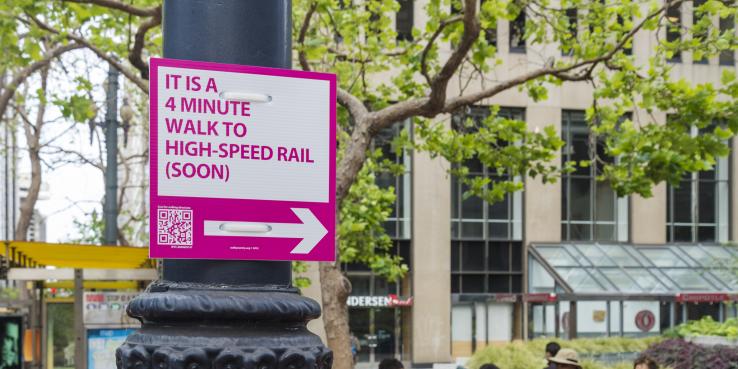Beginning in the 1970s, California’s leaders started to envision a way to connect the dense, urban coastal areas of the Bay Area and Southern California with the San Joaquin Valley via high-speed rail. A majority of California’s voters continue to support high-speed rail and the vision it can help the state achieve. A fast connection between the San Joaquin Valley and the coast could create significant economic growth to uplift cities along the route. An electrified train could help address air pollution in a region with some of the worst air quality in the country and create a clean way to travel across the state. In 2008, California voters agreed to devote approximately $9.95 billion to develop a high-speed rail system that would connect the agricultural communities of the San Joaquin Valley — such as Merced, Fresno, Kings/Tulare and Bakersfield — with the coastal cities of San Francisco and Los Angeles. High-speed rail is currently under construction in the Central Valley.
When complete, California’s high-speed rail system will fundamentally change people’s mental map of the state by making more places more accessible. Residents of Fresno will be about an hour and a half away from both San Francisco and Los Angeles, as opposed to up to three hours away by car.
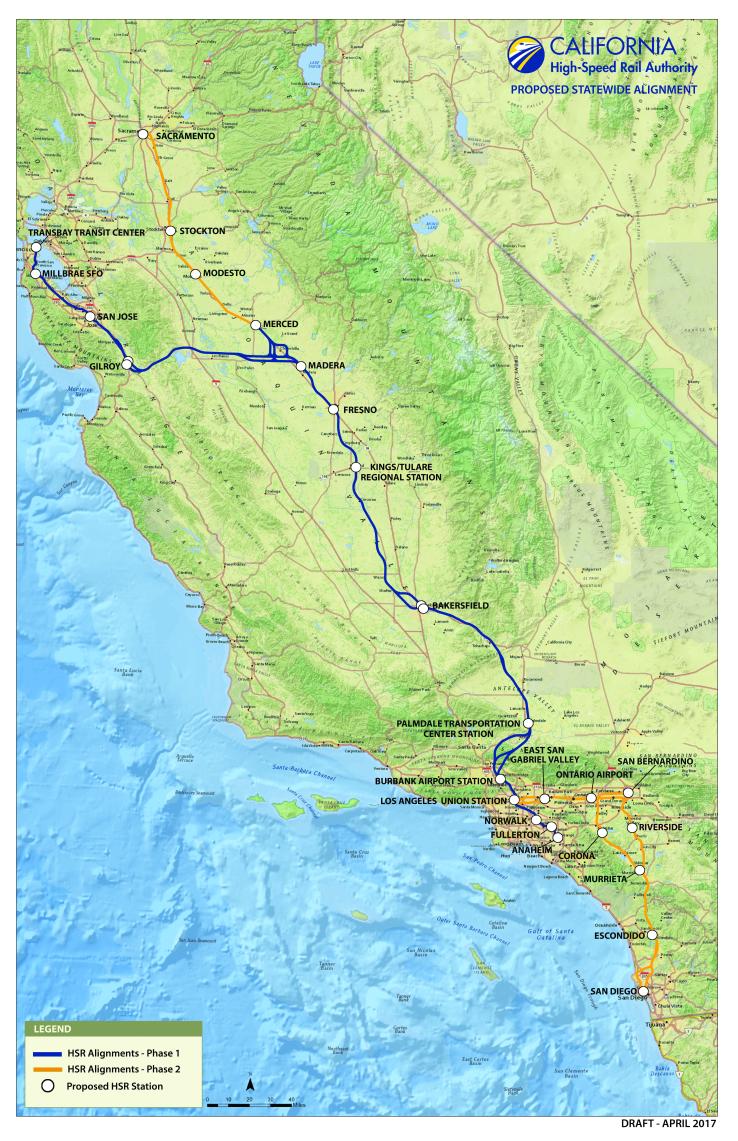
High-speed rail is more than a fast train. Stations can be anchors of public life and act as the “front door” to the cities along the route. By orienting more growth around these stations, cities in the network can also provide a foundation for how the state grows more sustainably in a world with a warming climate and more frequent, more damaging fires. By directing development in and around neighborhoods in station cities, California high-speed rail can also help stop sprawl and preserve the natural environment and greenfield areas under threat of development.
Over the summer and fall of 2021, SPUR, in partnership with the California High-Speed Rail Authority, produced a series of webinars to help the California High-Speed Rail Authority and station cities on their planning journey for high-speed rail stations and station areas. This article draws out some of the key themes and best practices we learned about, along with the concrete steps station cities and the authority can take to get the most from this generational investment.
Key Idea 1. Create a Network of Places
“If high-speed rail arrives and nothing is there, then people will go somewhere else.” — Andreas Heym, Founder, Andreas Heym Planning and Design
“A station is a piece of the city that is welcoming to the traveler.” — Andreas Heym
High-speed rail creates a network of places at multiple scales that reinforce each other, creating a key opportunity for station cities. At the network level, this investment creates fast new connections between places that were not previously connected. When completed, the high-speed rail network will connect eight of the 10 largest cities in California. The vision of high-speed rail can only be accomplished if we think of the station cities as a set of destinations that function better when connected.
At the local level, stations and the neighborhoods around them can be great urban places where people choose to spend their time — whether or not they ride the train. Local placemaking efforts can also help establish a city’s unique identity. And thinking of each city as part of a unified vision for the statewide network can open up new ways to experience the diversity of California. Cities in the Central Valley have the most to gain from concerted placemaking and identity-building efforts, which can help make these cities destinations, rather than places to pass through.
Steps to create a network of places:
- High-speed rail is a long-term urban project. Cities and the High-Speed Rail Authority should plan with an understanding that early investments will last 50 to 100 years and should support a city’s growth and aspirations in that same timescale.
- Cities and the authority should identify what the station can bring to the communities it serves, whether or not people ride the train. This means including amenities such as public spaces or businesses that serve the community, which should be identified by the community.
- The Authority and cities should prioritize the human experience of the stations and the streets around them, regardless of who owns or operates the stations.
The authority should build on prior efforts to work with cities to create consistent, identifiable station elements such as wayfinding signage, ticketing desks and platform canopies that people can associate with high-speed rail in any station city.
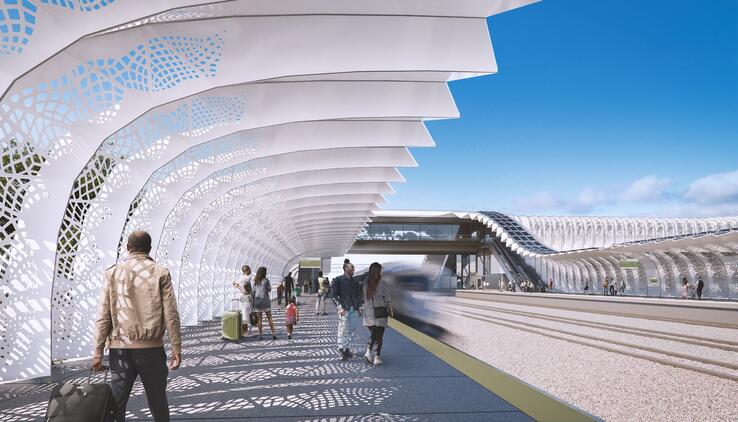
Design by Foster + Partners, visualization by Kilograph
Key Idea 2. Emphasize Placemaking and Identity
“Infrastructure is a very serious word. But I think there are opportunities to incorporate delight and joy and surprise into these places so that they are memorable.” — Kokila Lochan, Principal, VIA
“We try to elevate the culture of the existing community in search of permanence.” — Jason Foster, President and Chief Operating Officer, Destination Crenshaw
Central to the idea of creating a network of places is ensuring that stations and station areas express an identity and feel like a welcoming, humane place. Station design is an opportunity to elevate what is unique about every single one of the station cities in California, whether it’s the city’s geography, climate, social economic history or future.
Steps to accentuate identity and place:
- Locate high-speed rail stations in historic downtowns and within the existing community fabric. This will not only help support placemaking, but also reinforce historic patterns of growth, help contain sprawl and support economic development. For example, the high-speed rail station proposed for downtown Fresno has the opportunity to connect major neighborhoods such as downtown and Chinatown. By building a high-speed rail station in between these two neighborhoods, Fresno has the opportunity to create a hub where people can come together as one community.
- The Authority should recognize the differences in political leadership and civic capacity in different cities, and provide resources to community members to engage over the long-run. As Jessica Meaney from Investing in Place noted, the civic and organizing capacities in smaller cities like Palmdale are different than those in a large urban metro area like Los Angeles.
- Ensure that designs are thoughtful and representative of the time, place and culture of the neighborhoods in which they are built. One way to do this is to engage existing communities early in the design process and ensure that public agencies have the skill sets needed to work through differences, identify historical legacies and integrate community perspectives into plans and policies.
- Ensure that the public spaces around the station are comfortable and welcoming to residents and visitors alike. This also means making sure that all spaces are designed for a warming climate: create shaded spaces that offer protection against heat and are designed with people’s door-to-door comfort in mind. Bus stops and waiting areas should have shade trees and canopies.
Key Idea 3. Focus Growth Around Stations
“Density is a responsibility when it comes to an investment like this.” — Amit Price Patel, Partner, Urban Designer and Architect, DIALOG
A chief benefit of high-speed rail is that it has the potential to grow California's economy and share prosperity more evenly between regions, shaping California’s economic geography for the next century. If high-speed access can successfully draw investment in each of the station cities, high-speed rail will not only connect residents of the San Joaquin Valley to economic opportunities on the coasts, but will also make each station city more livable and bring economic diversity that will benefit current and future residents.
However, speakers cautioned that high-speed rail’s improved accessibility on its own is unlikely to change the economic trajectory for a station district, especially in Central Valley cities, which tend to have weak real estate markets. Success requires concerted planning and a coordinated land development strategy. In weak real estate markets, market rents and sales prices for multistory commercial and residential development — the types of buildings needed to make the most out of high-speed rail — are not high enough to cover the cost of building them.
In addition, speculation can stifle the timely development of land because people may buy vacant or underutilized land and hold it until the market is strong enough. Additionally, greenfield development is cheaper and easier to build than compact, higher-density growth. Getting growth to happen before, or alongside, the arrival of high-speed rail service in these places requires planning tools, financial subsidy and persistence. Cities need the appropriate tools to manage large-scale station area development, including planning and zoning, land acquisition, infrastructure financing and gap financing for new development. With the right tools to finance and manage station area development, California could see more jobs, housing, and other types of urban growth concentrated around high-speed stations.
These challenges elevate the importance of continuing collaborative efforts between the High-Speed Rail Authority and station cities to develop and implement station area plans, create site development plans, determine civic infrastructure needs to support new growth and more, as the authority is currently doing in Palmdale, Bakersfield, Merced and Fresno.
The COVID-19 pandemic creates an unexpected opportunity for Central Valley cities because it is changing how and where people work and live. A permanent hybrid work model, where many workers will only be required to be in an office part-time, makes people more tolerant of longer commutes. More affordable Central Valley cities on the high-speed route — like Fresno, Palmdale, Bakersfield and Merced — may be more attractive for workers who can work completely from home or infrequently commute to the office in other parts of the state.
Steps to focus growth around stations:
- Cities should create a vision statement and goals for their station and station area using a 100-year time horizon. Visualizing the vision statement and goals can further anchor the planning process and motivate political support.

Courtesy of AREP/SNCF French Railways
- Cities should develop their station area in parallel to the construction of the train line. If the market isn’t strong enough to support development, cites and the Authority should make upfront investments in station areas. This requires developing the capacity to partner with developers, acquire land, ensure that parcels are in shapes and sizes that can be developed, avoid conflicts with infrastructure where possible, and manage the sequencing of infrastructure investments and development.
- In addition to funding planning efforts, legislators should consider bringing back the institutional capacity and tools to fund, plan and manage station area redevelopment. At minimum, the state should increase the Authority’s budget to acquire land near stations, or provide funding directly to cities to purchase land and “bank” it for future uses such as affordable housing, or to make it more attractive for arts and culture organizations and economic development.
- The state should work with local communities and their respective regions to adopt additional forms of growth control in order to limit the urbanization of farmland and open space and capture more development within existing urbanized areas.
- The Authority and cities should maximize jobs and housing near the station. This involves numerous strategies to make effective use of the land, including zoning, public finance tools and parking management strategies. Some parking management strategies include avoiding putting parking right next to the station, offering preferential access for carpools, eliminating parking minimums for new development and implementing parking maximums.
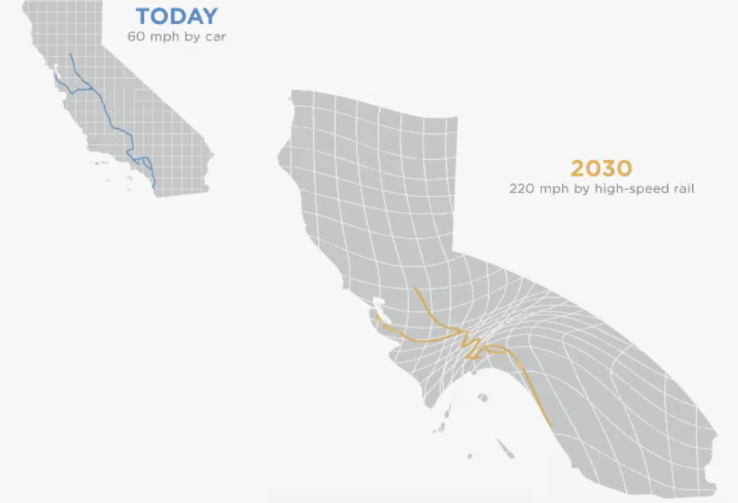
SPUR Graphic from Harnessing High-Speed Rail, 2017
Key Idea 4. Proactively Address the Potential for Displacement
High-speed rail can and should be a catalyst for new development, including commercial development as well as both market-rate and affordable housing. The statewide housing crisis requires the authority and station cities to be especially attentive to the potential for high-speed rail to increase property values near stations and to proactively take steps to avoid displacement.
The development of neighborhoods in and around high-speed rail stations should result in more housing and economic opportunities. Yet many are wary of new development because it can seem to foreshadow residential displacement, gentrification and a sense of feeling out of place in one’s community. Various studies suggest that new market-rate housing may lower prices regionally but increase them locally, that it may lower the rent for higher-priced housing units while increasing the rent for lower-priced units, and that it may lower rents and sale prices but increase the number of high-end amenities, which may or may not contribute to increased housing demand.
This suggests that, as a catalyst for housing growth, housing prices could be lower regionally yet higher locally, and that traditionally affordable units could become more expensive.
New housing around high-speed rail stations is a good thing; even now, many cities that will be served by high-speed rail are some of the fastest growing cities and are experiencing exploding costs. But it will not be sufficient to build enough market-rate housing; the high-speed rail cities must also protect tenants and build affordable housing to mitigate displacement and cultivate a sense of belonging. There will not be a one-size fits all solution but many mutually reinforcing strategies and different approaches for different markets.
Strategies to protect against displacement:
- The California State Legislature should require cities on the high-speed rail network to develop an anti-displacement strategy and should prevent cities from permitting car-oriented uses and large amounts of parking near stations.
- Cities should develop land use and public finance strategies that give existing residents an opportunity to stay in their neighborhoods. These can include value capture, public financing tools, right of return and others.
- Cities should use data and monitor early warning signs to track and adjust strategies. SPUR’s report Rooted and Growing suggests 1) collecting and using data to predict where displacement is most likely so that the correct agencies can respond and 2) studying displacement vulnerabilities and mitigations as part of a regional and local planning process. This can be incorporated into master plans for new high-speed rail station sites.
- The Authority should ensure that communities around stations are livable and provide for the needs of daily life by investing in local arts and cultural organizations, community centers, schools, parks and services, as suggested in Rooted and Growing.
- The Authority should ensure that there is a diverse mix of voices at the table when planning for high-speed rail stations. Rooted and Growing suggests that in order to create neighborhoods of belonging, leaders should, “Create an explicit process for an ongoing community dialogue between newcomers and longtime residents to process neighborhood change together.”
Key Idea 5. Improve Sustainable Mobility Across All Scales
“ In many ways, high-speed rail is one way to catalyze a different way to move around the state.” — Laura Tolkoff, Transportation Policy Director, SPUR
“It’s not just about people moving at the station, it’s about people moving all over the place … stations in fact are a pedestrian platform between modes, whoever owns it, whoever operates it. So stakeholders have to be aware of that and coordinate themselves” — Andreas Heym
High-speed rail is fundamentally about changing how we move and grow as a state, adding a new, more sustainable way to travel between cities that simply doesn’t exist today. But when many communities lack basic transportation infrastructure, it’s easy to get disillusioned about these grand ambitions. California and its cities should continue investing in networks of safe and accessible bicycle, pedestrian and local transit infrastructure today, while also building toward an integrated statewide transit network.
High-speed rail plays an important role in a transportation network, but it cannot be expected to do everything. Sidewalks and bike lanes support walking, rolling and biking within and between neighborhoods. Buses support travel within cities and between cities, and occasionally between counties and regions. High-speed rail is best suited for serving the intercity travel needs of cities — especially dense ones — rather than either cars or airplanes. For instance, high-speed trains do not get stuck in traffic and travel at much higher speeds compared to cars. Further, they provide a way to travel between cities without relying on polluting modes of transportation. Door-to-door travel times can compete with airplanes because train stations are typically closer to most people’s origins and destinations.
Each type of transportation infrastructure is needed, and we should continue to invest in local transit, pedestrian and bike networks. High-speed stations can also support mobility at every scale and provide real benefits to people living near future high-speed stations today.
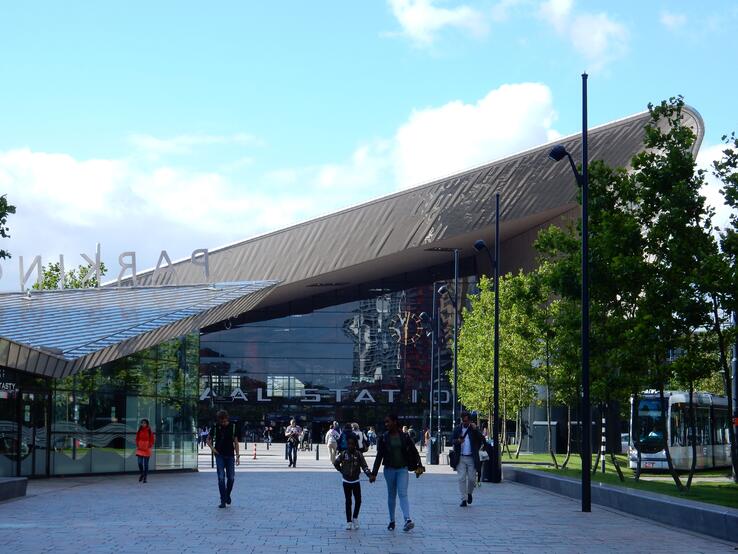
Photo by Laura Tolkoff
Steps to improve sustainable mobility across all scales:
- Stations should be located in accessible areas where they can connect with existing and planned transit.
- The state legislature should increase funding for transit operations and for active transportation programs.
- Cities should ensure that high-speed rail stations are located in dense, urban locations that give the best access to people traveling by foot, by bike and by transit. These space-efficient modes of travel open up space for jobs and housing and support sustainable access to and from the station.
- The authority should ensure that high-speed rail offers reasonably priced fares for low-income passengers. If people do not have to save up for a ride on a high-speed train, it can further differentiate itself from flying.
Conclusion
High-speed rail has the potential to drastically reshape California culturally, economically and geographically and to position the state as an economic and cultural leader within the United States and around the world. To fully realize these benefits, the investment in a fast train must be combined with targeted policies and investments to grow and share economic prosperity, create great places, stabilize and grow communities, and improve mobility at all scales.
Watch the recordings from our of webinars, produced in collaboration with the California High Speed Rail Authority:
- How Can High-Speed Rail Benefit Small- and Mid-Sized Cities?
- Using High-Speed Rail to Network Places
- How Can High-Speed Rail Benefit California’s Large Cities?
- How High-Speed Rail Will Reshape California’s Economic Geography
- Establishing Equity as the Crux of High-Speed Rail Planning
